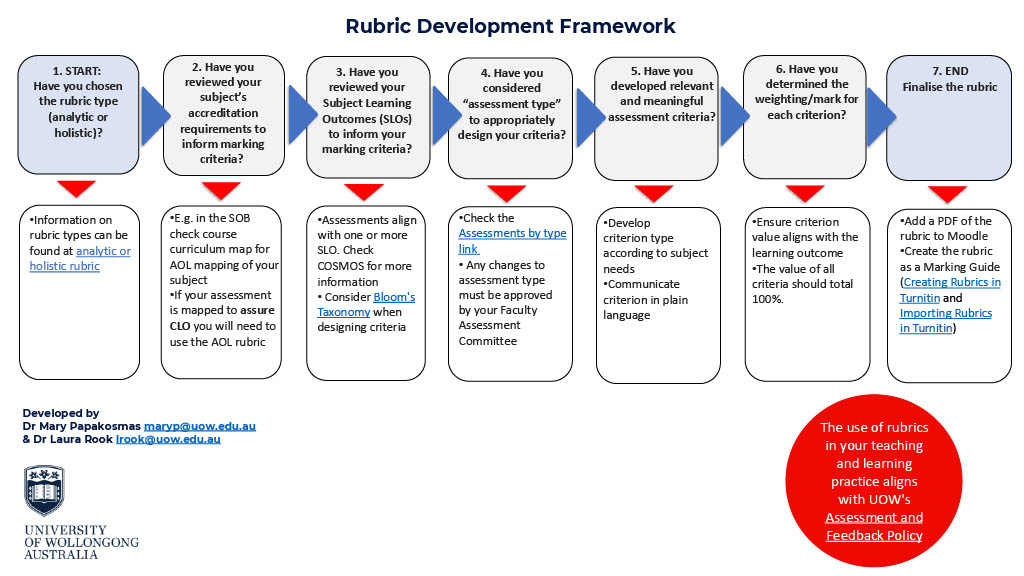Designing a Rubric Development Framework


Dr Mary Papakosmas & Dr Laura Rook
Faculty of Business and Law (BAL)
Dr Mary Papakosmas and Dr Laura Rook have created a Rubric Development Framework to support streamlined, consistent rubric design. Their primary goal was to improve student learning outcomes by enabling clearer, more structured feedback and to support academics by offering a practical tool to guide the process. In this showcase, Mary and Laura talk about the value of rubrics and their process of designing this framework.
In the following video, Mary and Laura introduce themselves and explain their rationale for developing a framework to support rubric design.
Laura: My name is Laura Rook and I'm an academic in the School of Business in the Faculty of Business and Law. I'm currently teaching the Integrated Business Capstone, which is a final year subject that all Bachelor of Business students need to complete.
Mary: My name is Doctor Mary Papakosmas. I teach public relations and communications in the School of Business.
Rubrics are a wonderful resource to ensure consistency in marking across the subject. And in my experience, it's been incredibly helpful. Several of the subjects I teach are very large student cohorts, so I have a reasonably large teaching team, all of whom are really committed to quality education.
So by being able to provide not only the students with a rubric that talks about expectations, but talking about that with a teaching team, I can ensure that marking is more consistent across my subject and across the various tutorials that are offered. And students in those various tutorials know that there's consistency as well.
So if they're talking with peers in different classrooms, they know what the expectations are and they know how those assessment tasks are being marked and what the outcomes are going to be.
Laura: What I was hoping to achieve with the Rubric development framework was to firstly enhance the student learning experience through helping educators to develop rubrics that are clear and structured and that use simple, understandable language. Hopefully students will then be able to review their expectations and we can have an impact on student outcomes, a more positive impact on student outcomes.
Mary: We were really trying to achieve something that was usable, that was actually user-friendly. So that when academics were considering how to improve the rubrics that they offer to students, there was actually a resource that was available to them that made sense to them, that connected with the outcomes that they were working towards for their students and was expressed in a way that was easy to understand.
To support student achievement of the learning outcomes, rubrics should:
- be clearly aligned with subject and course learning outcomes (Biggs & Tang, 2011), as well as relevant accreditation requirements
- include clear, measurable and fair criteria that align with the learning outcomes
- comply with UOW Assessment and Feedback Policy, and Academic Integrity Policy
- support consistency and fairness in assessment, particularly in large subjects with multiple cohorts and markers.
Building on Sadler’s (2009) proposition that changes to assessment practices should reduce workload for both students and educators. Mary and Laura designed a rubric development framework to support colleagues in designing effective, high-quality rubrics.
The Rubric Development Framework, pictured below, captures key stages and activities in the process. View the framework as PDF.

In the next video, Mary and Laura outline some highlights of the framework:
Mary: There are two things that I really love about the framework. And the first thing is its visual appeal. It's very simple, it's user-friendly, and its language is simple and user-friendly, which is all about what rubrics should be. The second thing is that it includes active links. So if you need further resources, you don't have to go and search for those subject learning outcomes, CLOs. They are all embedded in the document itself, so it enables academics to instantly go and follow up, get some more information and understand how those elements build into the rubrics that they're creating.
Laura: But what I really love about the framework is that it's, you don't have to just use it when you're designing a new rubric, a new assessment. What I really enjoy using it for is that I will take a rubric and look at my current assessment and then go through the steps of the process and go, oh, does something need to change if I've forgotten something? This is especially important when you're taking on a new subject or you want to refresh a subject. So it can be used both at the beginning when perhaps you're designing a new subject or assessment, but also just to reflect and re look at what you've already completed.
This framework offers practical, research-informed support for academics designing rubrics, with several key strengths:
- Best practice: This framework was developed through a Learning and Teaching project led by Mary and Laura. It draws on Dawson’s (2009) rubric design elements and Bearman and Ajjawi’s (2021) invitation to design assessment criteria that promote learning. By following the framework’s steps, you can create effective rubrics that align to subject and course learning outcomes and meet relevant accreditation requirements.
Note: Other readings curated by Mary and Laura during their research are included in the Additional resources section below. - Guided process: The framework offers a clear, user-friendly structure to help academics design comprehensive, thoughtful rubrics. For those in the School of Business, it also includes direct links to relevant learning outcomes.
- Customisation: The framework is designed for broad use across the school of Business, while allowing flexibility to adapt to your students’ learning needs and subject context. This flexibility supports the creation of rubrics that are meaningful and relevant to each course.
- Efficiency: Importantly, the framework streamlines the rubric design process; saving time and effort while maintaining high quality. This is particularly valuable for academics balancing multiple responsibilities.
Reflections
In this video, Mary Papakosmas and Laura Rook reflect on the iterative development of the framework.
Mary: Looking at the framework that we've created, I'm really pleased to say that we've achieved what we intended and that was quite simply something that's usable and something that collates and brings together all of the resources that academics need to consider when they're creating a rubric. So instead of them having to go and search websites and find links, everything is there. And we really started with the intent of creating something concise, clear, simple, user friendly and that I think is what we have.
Laura: The framework has been through a number of revisions, through an iterative process, consulting with colleagues across the university. So some of the original feedback we received was that there were too many steps in the framework and too much information actually included in the framework, that it just got too busy. And so we introduced links so that if you already knew, for example, accreditation or you already knew Bloom's Taxonomy, then you didn't have to click, you didn't have to read all about that. You could click on a link if you didn't know and you could go further. So we wanted to then I guess streamline it and make it shorter in terms of the steps because obviously again, academics are time poor just like anyone in the workplace.
One of the other bits of feedback that we received was accreditation. So a number of faculties across the university have accreditation requirements and so we got some feedback to say that definitely needs to be in there. And we didn't always have it, you know, one of the first steps, but it was really the feedback we got was it really needs to be considered upfront because it really can impact in terms of assessment design and outcomes. So we moved that around a bit. And so each of those bits of feedback have been integrated into the final version that you see today.
Advice for colleagues
In this video, Mary Papakosmas and Laura Rook offer advice to colleagues considering how to use the framework to support their rubric design.
Laura: My advice that I would give to our colleagues thinking about designing or developing a rubric is to give the rubric framework a go. Try it out, even with, you know, perhaps the subject that you you've inherited that you're taking over. That's new. Look at reflect, look at what's already there, go through the process and see if anything's been missed. We're all only human after all, and so we're always progressing and learning and I think that the framework can support that process.
Mary: The framework to me is something that's useful and I hope that you find it useful as well as you're developing your rubrics. I think if you have it alongside you while you're building your rubrics, it will make sense to you. And the process of rubric development will also make sense, especially when you think about what your subject is all about. What are the elements that really represent the essence of learning in your subject? You can convey that in your rubric, and students will actually benefit from that.
References
Bearman, M. & Ajjawi, R. (2019). Can a rubric do more than be transparent? Invitation as a new metaphor for assessment criteria. Studies in Higher Education. 46(2), 359–368. https://doi.org/10.1080/03075079.2019.1637842
Biggs, J. B. & Tang, C. S. (2011). Teaching for quality learning at university: What the student does (4th ed.). McGraw-Hill/Society for Research into Higher Education.
Dawson, P. (2017). Assessment rubrics: towards clearer and more replicable design, research and practice. Assessment & Evaluation in Higher Education. 42(3), 347–360. http://dx.doi.org/10.1080/02602938.2015.1111294
Sadler, D.R. (2009). Transforming holistic assessment and grading into a vehicle for complex learning. In: Joughin, G. (eds) Assessment, Learning and Judgement in Higher Education. Springer, Dordrecht. https://doi.org/10.1007/978-1-4020-8905-3_4
Additional resources
This section contains a list of resources curated by Dr Mary Papakosmas and Dr Laura Rook during their research:
Brookhart, S. M. & Nitko, A. J. (2008). Assessment and Grading in Classrooms. Pearson Education.
Cornell University. (2022). Using Rubrics. https://teaching.cornell.edu/teaching-resources/assessing-student-learning/using-rubrics
Handley, K. & Williams, L. (2011). From copying to learning: Using exemplars to engage students with assessment criteria and feedback. Assessment & Evaluation in Higher Education. 36(1), 95-108. https://doi.org/10.1080/02602930903201669
Orsmond, P., Merry, S. & Reiling, K. (2002). The use of exemplars and formative feedback when using student derived marking criteria in peer and self-assessment. Assessment & Evaluation in Higher Education, 27(4), 309-323. https://doi.org/10.1080/0260293022000001337
Popham, W. J. (1997). What’s Wrong – and What’s Right – with Rubrics. Educational Leadership. 55(2), 72–75.
Roell, K. (2019). How to Create a Rubric in 6 Steps. https://www.thoughtco.com/how-to-create-a-rubric-4061367
Tierney, R. & Simon, M. (2004). What's still wrong with rubrics: Focusing on the consistency of performance criteria across scale levels. Practical Assessment, Research, and Evaluation. 9(2).
https://doi.org/10.7275/jtvt-wg68



